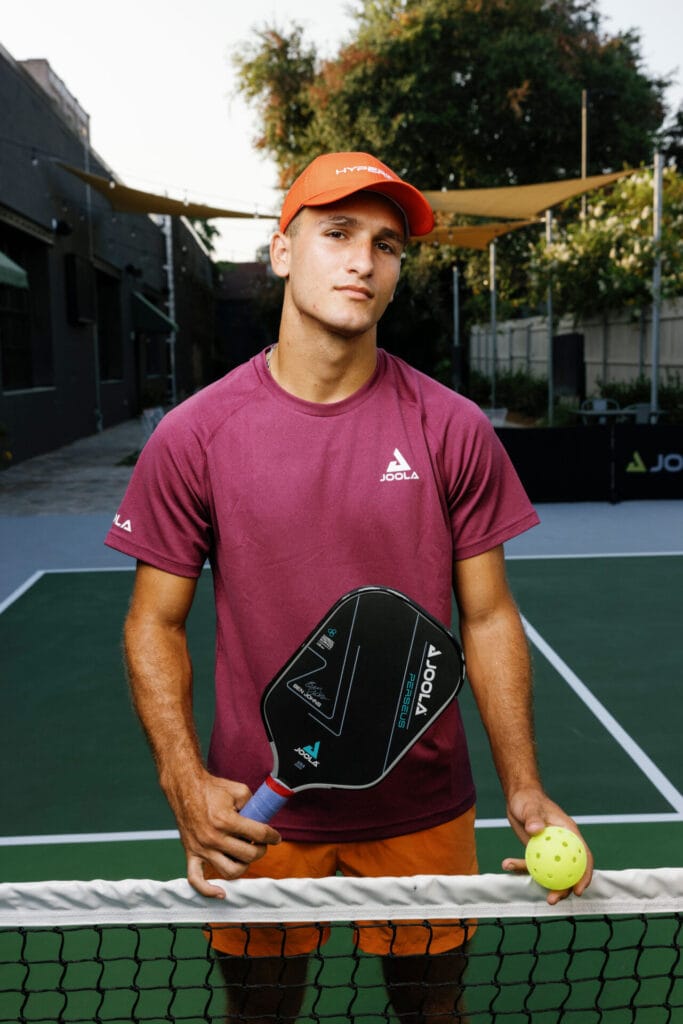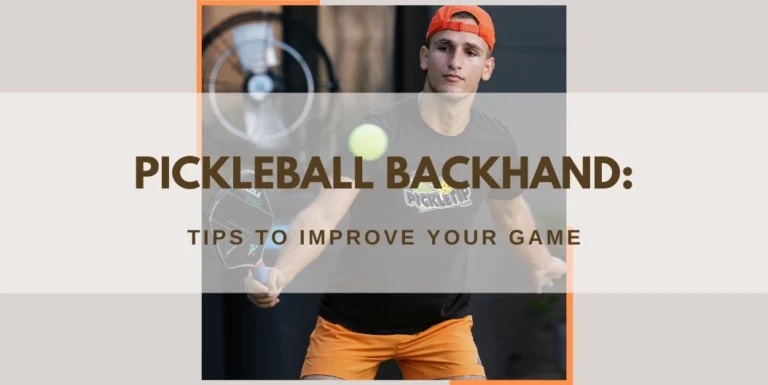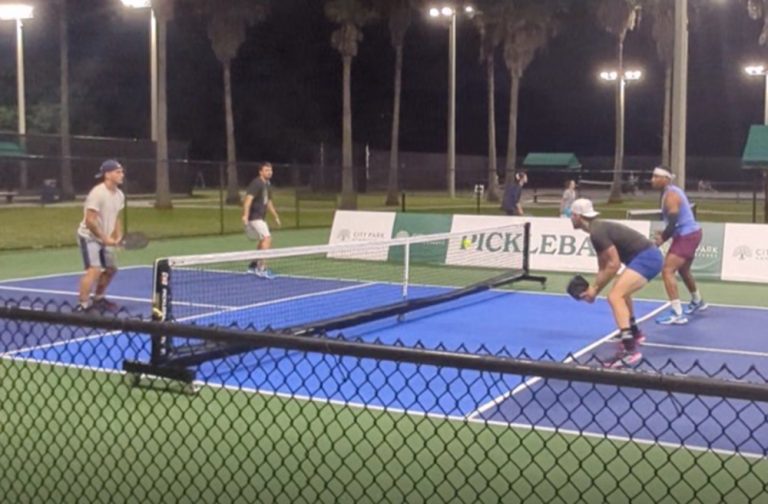Becoming A Wall at the Pickleball Kitchen Line
Pickleball Kitchen Line: Mastering Defense and Control
Pickleball success hinges on strategy, particularly at the kitchen line. This guide covers key aspects: exercises, conditioning, drills, body positioning, paddle angles, and grip pressure. It’s focused on mastering the kitchen line in pickleball.
The Strategic Pickleball Kitchen Line
Mastering the kitchen line is key in pickleball for every player. Known as the non-volley zone, it’s vital in court strategy. This seven-foot zone from the net offers strategic benefits. Understanding its importance can greatly enhance your game.
1. Dominance in Volleying
Gaining control of the kitchen line in pickleball is crucial. It allows volleys from closer to the net. This proximity limits opponents’ reaction time, making returns difficult. Closer positioning to the line offers more shot angles. Players can then aim shots with precision. They target the opponents’ weak spots effectively. This strategy enhances performance in the game.
2. Limiting Opponents’ Options
When a player or team controls the kitchen line, their opponents are often pushed back towards the baseline. This positioning limits the opponents’ shot options and increases their likelihood of making errors. The team at the kitchen line can exploit these limitations by executing drop shots, lobs, or fast volleys, forcing their opponents into defensive play.
3. Enhanced Angle of Attack
Being close to the net at the kitchen line provides a better angle for attacking shots. Players can hit downwards into their opponents’ court, which makes returning the ball more challenging. This angle also allows for a variety of shot types, including slices and spins, which can be more effectively executed from this position.
4. Importance of the Third and Fourth Shots
The third and fourth shots in pickleball rallies are crucial for kitchen line control. A skillful third shot, often a drop, helps teams advance to the kitchen line. This move shifts from defense to offense. The fourth shot responds to the third, key for control. It’s vital for regaining or cementing dominance at the line.
5. Psychological Edge
Controlling the kitchen line also provides a psychological advantage. Players who consistently dominate this area tend to intimidate their opponents, leading to errors and a defensive mindset. This mental edge can be as significant as the physical advantage, often influencing the outcome of the game.
6. Enhanced Defensive Capabilities
While the kitchen line is primarily seen as an offensive stronghold, it also enhances a team’s defensive capabilities. Being closer to the net allows players to react quickly to their opponents’ shots, especially smashes and volleys, and to cover more of the court efficiently.
The strategy of controlling the pickleball kitchen line is multifaceted. It involves not only reaching this critical zone but also performing effectively with a combination of offensive and defensive tactics. Mastery of the kitchen line can dictate the flow of the game, giving players the upper hand in rallies and significantly increasing their chances of winning points and ultimately, the match.
Exercises and Conditioning for Kitchen Line Mastery
- Slider Squats – Enhancing Range: Build lower-body strength and improve horizontal reach, crucial for stretching out to catch sneaky drop shots. Slider Squats are a variation of traditional squats using sliders or similar equipment to increase the challenge. This exercise focuses on building lower-body strength, particularly in the quadriceps, hamstrings, and glutes. By performing Slider Squats, players can build lower-body strength and improve their horizontal reach, which is crucial for stretching out to catch sneaky drop shots in pickleball.
- Single-Arm Deadlift – Increasing Strength and Stability: Strengthen and stabilize your body, using various muscles that are vital on the court. The Single-Arm Deadlift is a strength exercise that targets the muscles in the lower back, hamstrings, and core. It is performed using one arm at a time, which helps in improving balance and unilateral strength. This exercise is essential for pickleball players as it strengthens and stabilizes the body, using various muscles that are vital on the court for maintaining balance and power during play.
- Single-Arm Band Row – Boosting Shot Strength and Speed: Enhance muscle groups essential for powerful backhand and forehand shots. The Single-Arm Band Row is a resistance exercise that primarily targets the upper back muscles, including the latissimus dorsi, rhomboids, and trapezius. It is performed using a resistance band, focusing on one arm at a time. For pickleball players, this exercise is crucial for enhancing muscle groups essential for powerful backhand and forehand shots, contributing to both the strength and speed of their shots.
Specific Pickleball Drills
Dink Practice:
Focus on soft hands and ball control in dink exchanges. Dink Practice develops ‘soft hands’ for gentle ball touches. It involves continuous dinks over the net into the kitchen. The aim is to enhance ball control for precise placement. This hones hand-eye coordination and strategic thinking. Regular practice is key for mastering these shots. In high-level play, outmaneuvering beats power.
Volley Drills:
Improve reaction time and coordination with rapid volley exchanges in pickleball. Volley Drills boost reaction time and hand-eye coordination. They involve quick, bounce-less ball exchanges. This intense practice sharpens quick reactions and accuracy. It trains players for speedy, precise responses. Regular drills enhance timing and control under pressure. They focus on angle adjustments and shot strength. This fosters agility and strategic thinking in matches. Consistent volley drill practice is a game-changer for quick reflexes.
Shot Blocking:
Boost defensive skills with shot blocking and redirecting practice. Shot Blocking is key in pickleball and tennis. It’s about blocking and redirecting shots effectively. Training focuses on absorbing power and controlling shot direction. This skill neutralizes strong strikes, turning challenges into counter opportunities. It’s vital in fast-paced exchanges for shifting momentum. Regular practice improves wrist strength, reaction times, and anticipation. It helps players stay composed and make tactical decisions. Shot blocking mastery enhances defensive capabilities, making players formidable.
Tips for Improving Blocking Skills
- Stance: Adopt a wide and balanced stance with feet shoulder-width apart and knees slightly bent. Maintain a ready position with weight on the balls of your feet for quick lateral and forward/backward movements.
- Paddle Positioning: Keep your paddle out in front and center to cover the maximum area. Adjust paddle angles based on the shot type – flat for blocking and slightly angled for redirecting.
- Mental Preparation: Stay focused and anticipate your opponent’s moves. Practice mindfulness and breathing techniques to maintain calmness and quick reaction times.
Pickleball Kitchen Line: Common Questions
Q1: How do you effectively block a hard shot in pickleball?
A: To block a hard shot, adopt a low, balanced stance, keep your paddle ready in front, and use a firm grip. Anticipate the shot’s trajectory and use your paddle to redirect rather than overpower the ball.
Q2: What’s the best strategy for defending against power shots?
A: The best defense against power shots is a combination of quick reflexes, proper paddle positioning, and strategic body movement. Stay balanced, keep your paddle prepared, and use the opponent’s power to your advantage by redirecting the ball.
Body Positioning and Movement

Stance:
Maintain a wide, balanced stance, ready to move in any direction. Keep knees slightly bent for agility and quick movement. A wide, balanced stance is recommended, as it provides a stable base from which players can move swiftly in any direction. This stance involves keeping the feet shoulder-width apart, ensuring stability and balance, which is essential during rapid volleys and quick exchanges at the net. Additionally, keeping the knees slightly bent is key to maintaining agility and facilitating quick movements. This posture allows players to react swiftly to shots, whether they need to lunge for a low dink or stretch for a high volley. It also aids in quick lateral movements, crucial for covering the court effectively. A proper stance at the net in pickleball not only enhances a player’s defensive capabilities but also positions them to transition smoothly into offensive shots, making it a fundamental aspect of high-level play.
Movement:
Master quick lateral, forward, and backward movements for volleys and dinks. Lateral moves cover the court’s width, aiding in agility. Forward movements help approach the net for volleys or short dinks. Backward movements adjust to deeper shots or transition from net to baseline. These movements need speed, fluidity, and balance for shot control. Effective net movement in pickleball involves anticipation and efficiency. It enables optimal positioning and quick reactions to shots. This skill set is key in dominating net play and often dictates the game’s pace and outcome.
Paddle Handling
Paddle Angles:
Use flat angles for blocking and slight angles for redirecting shots. Paddle angles greatly impact game dynamics. Flat angles block powerful volleys or smashes effectively. They absorb shot energy, reducing speed and error risk. Slight paddle angles are crucial for redirecting shots. This places the ball in hard-to-reach court areas. Angling the paddle adds different spins and directions. It makes responses unpredictable and challenging for opponents. Mastering paddle angles enhances net play in pickleball. It combines defensive blocks with offensive redirects, boosting front court prowess.
Grip Pressure
Adjust grip pressure: relaxed for dinks, firm for volleys and defense. A relaxed grip suits soft dinks, allowing wrist flexibility. This helps guide the ball gently over the net. For volleys and defense, a firmer grip is needed. It provides stability and control against fast shots. Adjusting grip for each shot type optimizes paddle control. This enhances shot execution with accuracy and confidence. Mastering grip pressure adjustment is key for net play. It aids in seamless transitions between offense and defense in fast exchanges.
The Pickleball Kitchen Line
Mastering defense at the pickleball kitchen line is a journey of targeted exercises, strategic drills, and nuanced techniques. It’s about understanding key shots like resets and blocks. This court area is not just a battleground; it’s a chessboard of agility, strategy, and skill. Training refines these aspects, enhancing control and reducing errors. It transforms you into a formidable force at this crucial game point. Continuously evolving these skills, you become more proficient, confident, and resilient. The journey to excellence at the kitchen line is both challenging and rewarding. With persistent effort and strategic focus, you can master this vital zone. This makes you an invaluable team asset and a respected opponent in the pickleball community.







